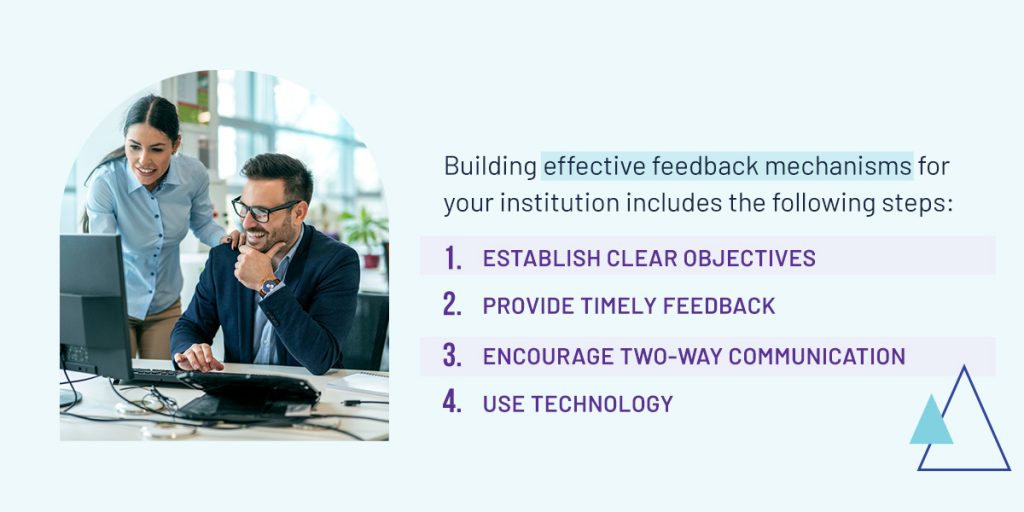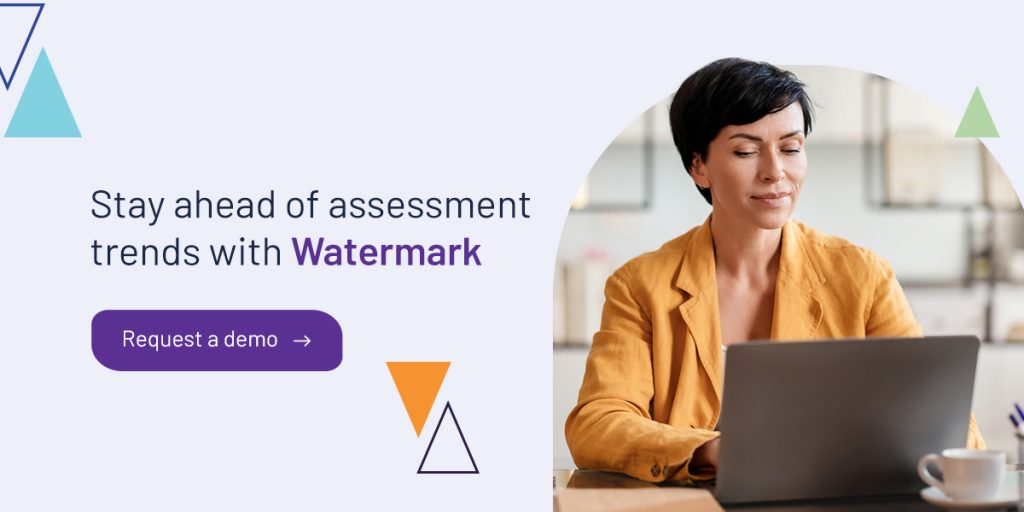
Assessment is multifaceted. It improves student learning outcomes and drives continuous improvement. Each student entering higher education comes from a different background and has different needs and abilities. It’s up to institutions like yours to create an impactful learning experience for them. To achieve this, you need a dynamic and effective assessment strategy.
As assessment trends change, institutions transform their strategies in response to rapid technological advancements and evolving student needs. Evolving alongside these trends requires a comprehensive view of student performance. Your assessment practices must be innovative and drive your institution toward achieving its mission.
Understanding the need for evolution in higher education assessment
Assessment has long been a cornerstone in higher education. However, recent higher ed assessment trends tell us the landscape is much more dynamic today. While traditional assessment methods still have their place, innovative technology has paved the way for a more personalized, flexible understanding of student success.
Artificial intelligence (AI), in particular, has revolutionized how we use data. Institutions are increasingly adopting it to inform strategic decision-making, enhance the student experience, and link course content to real-world outcomes. As some higher education professionals predict, AI will quickly become critical infrastructure for universities.
Students are becoming more discerning and increasingly skeptical of the value of higher education. To maintain the right momentum, institutions need to use assessment to improve the student experience and create roadmaps to high-value careers.
Key strategies for evolving assessment methods to align with current trends
As assessment trends evolve, many institutions encounter challenges in keeping up with the necessary redesigns. Assessment must be meaningful and relevant, providing an accurate picture of student performance that you can use to inform decision-making. In addition, assessment is no longer just about compliance with accreditation criteria — it’s about improving every aspect of your institution.
Despite these nuances, assessment must also be simple and accessible. The following tips can help you evolve your assessment strategy and stay agile in a changing landscape:
Adopt technology-driven higher ed assessment tools
Technology has already transformed every aspect of higher education, from teaching and learning to assessment. It helps create personalized learning experiences, connects students worldwide, removes the administrative burden on faculty, and more. Technology has had the most crucial impact on assessment, unlocking data your institution can use to inform continuous improvement. It allows you to connect with at-risk students and engage faculty in the teaching experience.
Higher ed assessment software helps you improve assessment beyond the present. Investing in the right tools enables large-scale data analysis, revealing actionable insights that inform current and future strategic decisions. You can focus on value-added tasks when you have the tools and infrastructure to access and understand your data. You also have a holistic picture of student engagement, which you can use to inform outreach and resource allocation.
Implement continuous feedback mechanisms
Agile assessment practices mean establishing a regular, iterative process for gathering feedback and using it to enhance teaching and learning. It starts with creating a culture of continuous feedback at your institution so that everyone involved plays a role in refining and rethinking assessment practices. Building effective feedback mechanisms for your institution includes the following steps:

- Establish clear objectives: Your first step is to have concrete objectives for each course and ensure they align with overarching student learning outcomes.
- Provide timely feedback: Give students and faculty prompt feedback after assessments and activities so they can make the necessary adjustments in real time. Clearly state that feedback is part of the assessment process and emphasize its role in continuous improvement.
- Encourage two-way communication: Facilitate a dialogue between students and faculty, allowing both to provide feedback that enhances the learning experience.
- Use technology: Implement digital tools to streamline the feedback process, encourage valuable responses and make it more engaging for all stakeholders.
Foster collaborative assessment practices
Assessment is a team effort. It involves assessment practitioners, students, faculty, student affairs, and external stakeholders. With the assessment goalposts likely to change, everyone at your institution must be on the same page. Leverage technology to get a holistic view of your assessment practices and allow everyone to collaborate on the same goals.
Individual program objectives should always align with programmatic outcomes, which should feed into your institution’s mission and strategic plans. When everyone can see your assessment progress, they understand their contributions to your institution. Identify, align, and share assessment outcomes to create a shared understanding across stakeholder groups. Check in regularly to make adjustments and communicate your progress.
Case studies and success stories
Evolving assessment practices are achievable for any institution with access to high-quality, actionable data. Below are some success stories of institutions that have successfully overcome challenges and evolved their assessment strategies:
Union University
At Union University, assessment and accreditation processes held the institution back. Information overload made assessment needlessly complex. They began building a culture of continuous improvement and leveraging intuitive technology to achieve their assessment goals. With Watermark Planning & Self-Study, administrators cut reporting time by 50 percent, creating a digital accreditation and reporting process in just six weeks.
William Woods University
Although William Woods University had a strong assessment culture and processes, it wanted to save time with a technology directly integrated into its learning management system (LMS). They began their transformation by searching for a scalable, flexible, and reliable solution to adapt to their changing assessment needs.
William Woods adopted Watermark Student Learning & Licensure for dual LMS integration and course-embedded assessment. Within a year, they had conducted course-level assessments in all on-campus undergraduate programs, leveraging masses of high-quality data to document evidence of student learning.
The University of Alabama College of Education
The University of Alabama College of Education had existing assessment processes. However, it encountered various challenges, including overlapping systems, data silos, tool overload and inauthentic assessment practices. Faculty were frustrated, and the College of Education sought to streamline and improve assessment to address these challenges.
They began by seeking a solution that fostered an authentic, continuous improvement and collaboration culture. This search led them to adopt Watermark solutions, including Watermark Faculty Success, Student Learning & Licensure, and Planning & Self-Study. They used this suite to consolidate their tech stack and create a shared governance assessment system. Within a few years, they experienced a cultural shift toward authentic assessment practices, enhanced collaboration, and more efficient, data-informed processes.
Stay ahead of assessment trends with Watermark

Your assessment strategies must evolve constantly to provide students, faculty, and other stakeholders with the best possible results. The right tools enable you to improve student outcomes, achieve institutional objectives, and inform meaningful change.
With Watermark, you can access high-quality data to streamline your assessment practices and maximize your institution’s impact. Our suite of solutions simplifies assessment, allowing you to measure your effectiveness and communicate it effortlessly from a single centralized hub. Book a demo today to stay agile in the face of changing assessment trends.















































































































































































































































































































































































































